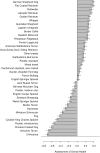Dog Owners' Perspectives on Canine Dental Health-A Questionnaire Study in Sweden
- PMID: 32582779
- PMCID: PMC7297050
- DOI: 10.3389/fvets.2020.00298
Dog Owners' Perspectives on Canine Dental Health-A Questionnaire Study in Sweden
Abstract
Periodontal disease is one of the most common diseases affecting dogs, with a reported prevalence of at least 80% in dogs over 3 years of age. However, there is a lack of studies regarding dog owners' assessment of their dog's dental health, and whether they perceive clinical signs often associated with periodontal disease, i.e., dental calculus, halitosis or mobile or lost teeth. A validated questionnaire survey was distributed to all Swedish dog owners with email addresses in the national registry (n = 209,263). The response rate was 32%. The survey questions concerned opinions and practices regarding canine dental health, including assessment of dental health parameters and dog owners' ability to examine their dog's mouth. A construct (α = 0.76) was used to investigate dog owners' assessed symptoms of their dog's dental health in relation to background factors. Half of the respondents rated their dog's dental health as very good. However, one in four dog owners experienced difficulties when inspecting the dog's teeth. The most common reason for this difficulty was stated to be an uncooperative dog. Almost half of the dog owners reported halitosis to some degree in their dog, and almost four in ten owners reported dental calculus. One in eight dogs had been previously anesthetized for dental cleaning, and one in 12 dogs had experienced problems with gum disease, according to the owners. Owners' assessment varied significantly with the dog's age, weight, breed, breed group, sex, and concurrent disease. Owner-related factors that influenced the assessment of the dog's dental health were age, gender, education, county (urban/rural), and whether they were breeders or not. Dog owners with smaller dogs, older dogs and certain breeds predisposed to periodontal disease assessed their dog's dental health as worse than their counterparts, which is in agreement with previously reported higher prevalence of dental disease in these groups. This indicates that dog owners are able to perform relative assessment of their dog's dental health status. Our results also highlight the need for routine professional assessment of periodontal health, as well as education of dog owners and training of dogs to accept dental care procedures.
Keywords: breeds; dental health; dog; periodontal disease; survey.
Copyright © 2020 Enlund, Brunius, Hanson, Hagman, Höglund, Gustås and Pettersson.
Figures



Similar articles
-
Dental home care in dogs - a questionnaire study among Swedish dog owners, veterinarians and veterinary nurses.BMC Vet Res. 2020 Mar 18;16(1):90. doi: 10.1186/s12917-020-02281-y. BMC Vet Res. 2020. PMID: 32188446 Free PMC article.
-
Dog owners' perceptions and veterinary-related decisions pertaining to changes in their dog's behavior that could indicate pain.J Am Vet Med Assoc. 2024 Jul 19;262(10):1370-1378. doi: 10.2460/javma.24.02.0120. Print 2024 Oct 1. J Am Vet Med Assoc. 2024. PMID: 39032508
-
Development and validation of two questionnaires: Dental home care and dental health in Swedish dogs.PLoS One. 2019 Jan 25;14(1):e0204581. doi: 10.1371/journal.pone.0204581. eCollection 2019. PLoS One. 2019. PMID: 30682017 Free PMC article.
-
Acquiring a Pet Dog: A Review of Factors Affecting the Decision-Making of Prospective Dog Owners.Animals (Basel). 2019 Mar 28;9(4):124. doi: 10.3390/ani9040124. Animals (Basel). 2019. PMID: 30925784 Free PMC article. Review.
-
Ethical Concerns about Fashionable Dog Breeding.Animals (Basel). 2024 Feb 28;14(5):756. doi: 10.3390/ani14050756. Animals (Basel). 2024. PMID: 38473141 Free PMC article. Review.
Cited by
-
Long-term effects of motivational interviewing vs. traditional counseling on dog owners' adherence to veterinary dental home care: a three-year follow-up study.Front Vet Sci. 2024 Feb 26;11:1296618. doi: 10.3389/fvets.2024.1296618. eCollection 2024. Front Vet Sci. 2024. PMID: 38596465 Free PMC article.
-
Evaluation of a Thiol-Detection Test to Assess Tooth Brushing Efficacy in Dogs.J Vet Dent. 2024 May;41(3):183-191. doi: 10.1177/08987564231179898. Epub 2023 Jun 22. J Vet Dent. 2024. PMID: 37345423 Free PMC article.
-
Modifiable early life risk factors for dental calculus in dogs: a retrospective cross-sectional study in Finland.BMC Vet Res. 2025 Jul 2;21(1):430. doi: 10.1186/s12917-025-04885-8. BMC Vet Res. 2025. PMID: 40604839 Free PMC article.
-
Improved Oral Health and Adaptation to Treatment in Dogs Using Manual or Ultrasonic Toothbrush or Textile of Nylon or Microfiber for Active Dental Home Care.Animals (Basel). 2021 Aug 24;11(9):2481. doi: 10.3390/ani11092481. Animals (Basel). 2021. PMID: 34573447 Free PMC article.
-
Association between Dog Owner Demographics and Decision to Seek Veterinary Care.Vet Sci. 2021 Jan 5;8(1):7. doi: 10.3390/vetsci8010007. Vet Sci. 2021. PMID: 33466270 Free PMC article.
References
-
- Hamp SE, Olsson SE, Farsomadsen K, Viklands P, Fornell J. A macroscopic and radiologic investigation of dental diseases of the dog. Vet Radiol. (1984) 25:86–92. 10.1111/j.1740-8261.1984.tb01916.x - DOI
-
- Fernandes NA, Borges APB, Reis ECC, Sepúlveda RV, Pontes KCDS. Prevalence of periodontal disease in dogs and owners' level of awareness - a prospective clinical trial. Revista Ceres. (2012) 59:446–51. 10.1590/S0034-737X2012000400003 - DOI
-
- WSAVA World Small Animal Veterinary Association Global Dental Guidelines. (2018). Available online at: https://wsava.org/wp-content/uploads/2020/01/Dental-Guidleines-for-endor... (accessed May 27, 2020).
LinkOut - more resources
Full Text Sources

